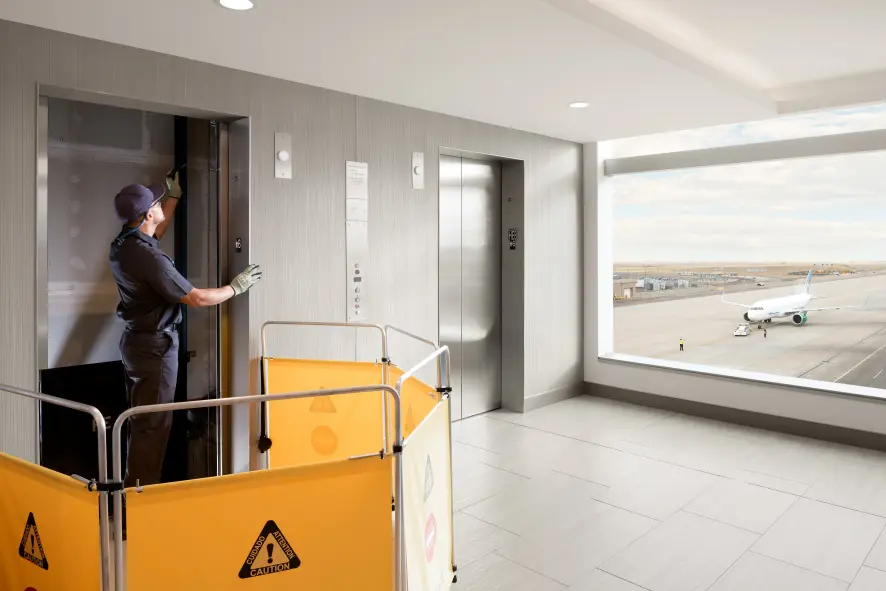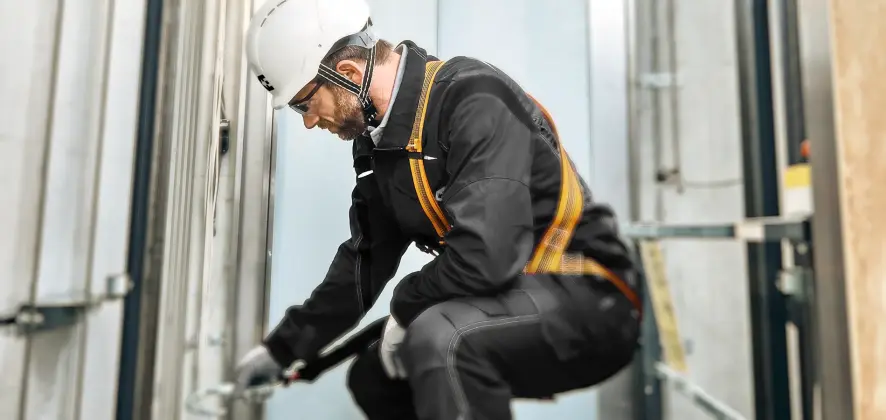Safety, Compliance, and Regulatory Aspects of Elevator Modernization
When it comes to elevators, safety is of paramount importance. Any solution, whether a partial elevator modernization or full elevator replacement, must result in a code-compliant and safe elevator system. A key consideration is that building codes and elevator safety standards may have evolved since an old elevator was first installed. Examples for this are the requirement to install modern door safety features like infrared door sensors that prevent doors from closing while passengers are still entering or exiting the elevator car, adding fire recall systems, and ensuring adequate ventilation and emergency lighting in the elevator car.
In short, a properly scoped modernization will address any safety gaps of the old system and result in an elevator that meets current safety standards.

Market Conditions and Challenges to Elevator Modernization in India
India presents a unique landscape for elevator modernization and replacement. The country’s building stock is a mix of gleaming modern high-rises and older structures with legacy lift installations. With rapid urban growth, India has become one of the largest elevator markets in the world, primarily driven by new installations in residential and commercial buildings. However, as many of these elevators were installed during the early boom of the 2000s and 2010s have now come of age, the demand for lift modernization is rising.
Elevator Safety Regulations in India
Regulatory requirements vary globally. In India, states have so-called Lift Acts or rules that govern elevator safety, requiring periodic inspections and certification of lifts. Modernization in India often must align with the Bureau of Indian Standards (BIS) codes and the National Building Code.
In the past, elevator safety standards and enforcement in India were not as stringent as in some other countries. Many older lifts (especially in residential buildings) have manual doors and no emergency communication. In recent years, high-profile accidents and a general rise in safety awareness have prompted stricter regulations. The Indian Standards (BIS) have been updated – for example, IS codes now mandate features such as Automatic Rescue Devices (ARD), fireman’s mode, emergency alarms, and overload protection in new elevators. State governments (through Lift Acts) require regular inspections and fitness certifications for lifts. Maharashtra, for instance, has comprehensive rules for lift safety, including requirements to retrofit certain safety devices in old lifts. Building owners and housing societies in India are increasingly proactive in modernizing elevators to comply with these updated safety norms and avoid penalties or shutdowns. In some states, if an old elevator is deemed unsafe, authorities can demand that it be taken out of service until upgraded. Thus, regulatory compliance is a strong motivator for modernization in India.
Regulatory Spotlight: The Bureau of Indian Standards
The Bureau of Indian Standards has specific codes for elevators (IS 14665 series for electric elevators, IS 15259 for testing, IS 14671 for lifts for persons with disabilities, etc.). In 2019, as noted, IS 17386 was introduced to guide the replacement of existing lifts. This shows an official recognition of the modernization/replacement process in the standards, providing a framework to ensure safety when an old lift is swapped with a new one in the same shaft. Compliance with BIS standards is usually mandatory when making major modifications or replacements, hence, any modernization in India should refer to these codes. For example, the IS guidelines will dictate requirements like governor overspeed switches or buffer designs if you upgrade certain components.
From a liability and risk standpoint, both options, partial elevator modernization and full replacements, can achieve top-notch safety, but attention to detail is key. A reputable partner will survey your existing system, identify all code non-compliances, and then either include their remedy in the lift modernization plan. Building owners in India should ensure that modernization proposals explicitly include the necessary safety scope (doors, interlocks, buffers, etc.), since sometimes bids omit certain items, leading to incomplete compliance.
TK Elevator: The Gold Standard for Safe and Compliant Elevator Modernization
As one of the top global elevator companies, with particular strengths in providing custom engineering solutions, safety and compliance are always our top priorities.
Whether your primary goal is to reduce energy use, maximize capacity, or modernize with minimal downtime, we have likely encountered a similar scenario in India already and have the ability to develop an effective solution.
This reflects on our strength in project management and customization: we aim to keep projects on time and within budget while minimizing disruption.
We are also very familiar with the common shaft sizes in India and constraints in older buildings. Thanks to our strong local presence with branch offices in all major Indian cities, we are well-positioned to execute projects smoothly no matter where you are located.
Notably, in India, we have a significant presence with manufacturing and spare part sourcing capabilities, which allows us to customize modernization solutions to Indian building conditions.
Also, many Indian buildings have older elevators installed by various local companies. Throughout our modernization packages, these can be upgraded to international safety and performance standards. We can retrofit features like ARD, seismic sensors, and modern controllers in full compliance with Indian Standards to elevators made by all major manufacturers.
In situations where installing a new elevator is the best choice, we are also able to accommodate that. Thanks to our dual expertise in both partial modernization and full replacement, we are a strong partner to support your elevator lifecycle management plan.

Recap: Tightening Regulations and Improving Elevator Safety Requirements are the main drivers for Elevator Modernization in India
To recap, India’s elevator market is at an inflection point where modernization and replacement projects are ramping up. Regulations are tightening, user awareness is growing, and the aging of installed elevators is creating a wave of required upgrades. The unique challenges of cost sensitivity, varied building conditions, and enforcement issues shape how these projects unfold.
Nonetheless, the trajectory is clear: Indian buildings, whether a 50-year-old Mumbai high-rise or a 15-year-old Gurgaon office tower, will see continued elevator modernization and, in some cases, full replacements to improve safety, efficiency, and experience. For building owners and facility managers in India, it’s advisable to stay ahead of the curve: plan for elevator upgrades proactively. Modernization, when done right, is a sound investment in the functionality and value of Indian properties, very much in line with the global best practices, yet tailored to local conditions. Contact your nearest branch today to learn how we can help you. To understand whether partial modernization or full replacement is the better approach in terms of cost-efficiency, check out our blog post on Elevator Modernization Lifecycle and ROI Considerations.
 India
India


